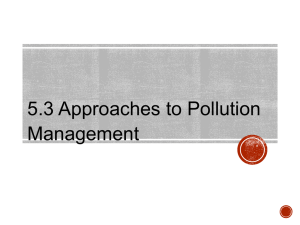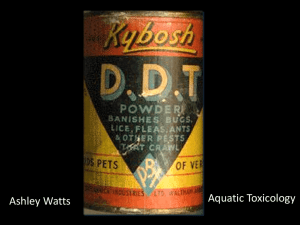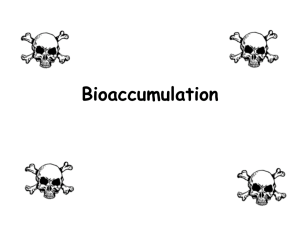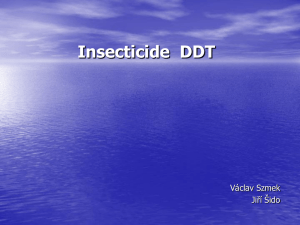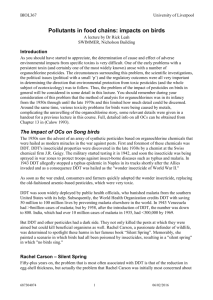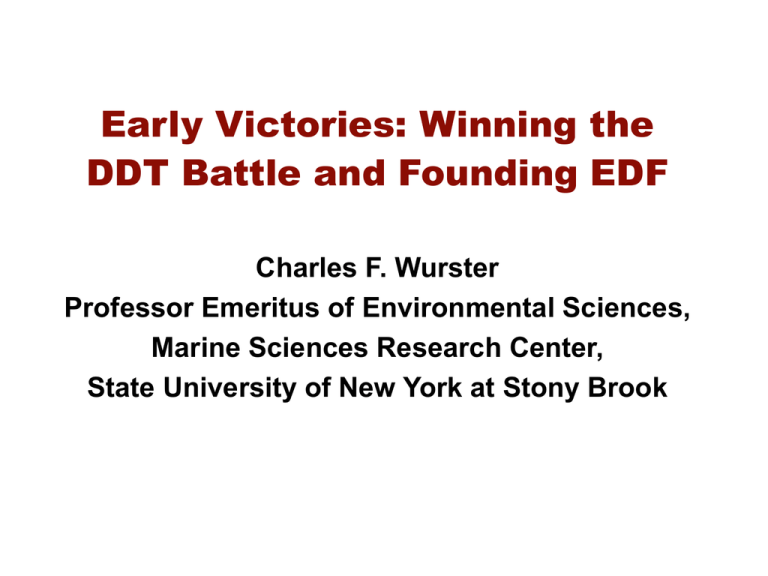
Early Victories: Winning the
DDT Battle and Founding EDF
Charles F. Wurster
Professor Emeritus of Environmental Sciences,
Marine Sciences Research Center,
State University of New York at Stony Brook
Lecture Outline
Developing problems, especially for birds
Properties of DDT
Toxicity mechanisms
Founding of Environmental Defense Fund, EDF
Achieving the ban on DDT
The birds recover
•
•
•
•
DDT first synthesized in 1874 as lab curiosity.
Mueller discovered insecticidal properties in 1939, won
Nobel Prize.
World War II – DDT effective against Typhus and Malaria,
helped win war. DDT was not thoroughly tested, but it
was wartime! It did not kill people.
Post-WWII, 1947: DDT into widespread use for numerous
insect problems.
Problems soon developed.
Early Problems with DDT
1949 – “Nightmarish” insect control problems in Canyete Valley, Peru.
DDT destroyed natural enemies and resistance developed
rapidly.
1948 – Dutch elm disease spraying = dead birds in Princeton, NJ.
1950s – Reproductive failure in Western Grebes, Clear Lake, CA
1950s – Declining raptor populations in Europe, N America.
Osprey, Peregrine, Golden Eagle, Eurasian Sparrowhawk,
others, suffering mortality and reproductive failure.
Western Grebes
DDD at 14, 20, and 20 ppb was added to lake to control gnats.
Grebes dropped from 1,000 pairs to 15 by 1959.
Fatty tissues contained 656-723 ppm (35,000x higher than
what was added to the lake).
• Earliest case of biological concentration.
American Woodcock
1950s – Reproductive failure in New Brunswick, Canada.
Forests sprayed with DDT had lower reproductive success
than unsprayed areas.
.
Osprey
1938-1965 – Reproductive failure in the Eastern USA
• S Connecticut: 200 pairs in 1938, dropped to 12 pairs in 1965
• Long Island, NJ populations in steep decline.
Young
Per Nest
DDT in Eggs
(ppm)
Normal
2.3
-
Maryland
1.1
3.0
Connecticut
0.5
5.1
Bald Eagle
1940s-1970
Declining reproductive
success and populations in
Lower 48.
DDT and Dieldrin found in all
eagles and eggs analyzed.
Eggs averaged10 ppm DDT,
less Dieldrin.
Eurasian Sparrowhawk
1950 -1960s - Declining
population, egg breakage,
egg eating, in Eurasian
Sparrowhawk.
DDE and Dieldrin present
in eggs, adult fatty tissues,
and chicks.
Peregrine Falcon
1940s – 1970s – world’s fastest bird,
favorite of falconry.
• Severe reproductive failure, N America and
Europe, broken eggs, egg eating, extinction
E of Rockies, became rare in West.
• Madison Conference 1965 documented
decline, produced book, blamed “pesticides.”
• DDT and/or Dieldrin considered most likely
cause, substantial circumstantial evidence, not
proof.
1950-1970 - Other species with
reproduction problems:
Brown Pelicans laid “omelets,” 50% shell thinning,
produced no chicks on Channel Islands off LA.
Montrose Chemical Co.!
Golden Eagles in Scotland, probably from Dieldrin in
sheep dips.
Bermuda Petrel in North Atlantic.
Herring Gull in Great Lakes. Lesbian Gulls.
Kestrel, Prairie Falcon, Barn Owl, Buzzard, Merlin,
Hen Harrier, Sandwich Tern
Inadequate data for conclusions.
Note: All above birds are carnivores.
No herbivores.
1948-1970 – Direct mortality of songbirds from
widespread spraying for Dutch elm disease,
especially in MI, WI, IL, NH.
Killed millions of birds, did not save elm trees.
1962 – “Silent Spring”
Other problems with DDT, Dieldrin
- Mortality, reduced reproduction in fish;
phytoplankton; carcinogenesis.
- Frequent failure at insect control, often makes
pest problems worse through resistance,
mortality of pest parasites and predators.
Properties of DDT
1. Persistence
(stability)
DDT very stable
in environment.
DDE is more so.
DDE causes thinshelled eggs, is
carcinogenic.
Properties of DDT
2. Mobility
Vapor pressure very low, but not zero.
Water solubility very low, but not zero.
Co-distils from wet surfaces.
Enters air and water circulation patterns.
Falls in the rain.
Contaminates most higher organisms, all people,
even Antarctic penguins.
Once released, is uncontrollable.
Properties of DDT
3. Solubility Characteristics
Water insoluble, lipid (fat) soluble.
Partitions from inorganic environment into lipidcontaining organisms.
Biological concentration, builds up in food chains.
Carnivores receive highest concentrations.
Properties of DDT
4. Biological Activity –
DDT and DDE are biologically active by several mechanisms.
a. Acute toxicity, blocks sodium channels in nerve axons,
leads to tremors and death at sufficiently high dosage.
Kills insects, songbirds following Dutch elm disease spraying.
b. Estrogenic, male gulls disinterested in breeding,
lesbian females.
c. Enzyme induction in liver. Broad spectrum enzyme break down
toxicants plus female sex hormones. Affects Ca metabolism.
d. Enzyme inhibition, especially Ca-ATPase in oviduct.
e. Carcinogenic, DDE causes cancer in lab animals.
Conclusions
DDT/DDE are stable, travel about the world,
partition into organisms, concentrate in food
chains, and are biologically active.
Dieldrin, other organochlorine pesticides, PCBs,
phthalate ester plasticizers, many other chemicals
contaminate our ecosystems.
Effects of most are unknown.
Results with DDT/DDE for birds:
Acute mortality and reproductive failure.
Reproductive Failure
• Egg breakage, egg eating, un-hatched eggs
• Problem with calcium metabolism
Peregrine egg, broken
Bald Eagle nest,
broken egg + chick
Peregrine eggshell
thicknesses, UK,
1900-1970, 20%
thinner after 1947.
Sparrowhawk
eggshell thicknesses,
UK, 1900-1970, 16%
thinner after 1947.
Ratcliffe, Nature 215, 208 (1967) – Eggshell thicknesses in UK, 1900-1967.
- Golden Eagle eggshells thinned by 8% after 1947.
-Hickey & Anderson (1968) showed 18% eggshell thinning in
Peregrines in North America. Similar thinning in Bald Eagles,
other raptors. As in Europe, thin shells started 1947.
Coincidence?
DDT introduced widely into World environment, 1945-1946.
Other variables also present: radiation, other pesticides, PCBs,
dieldrin, heptachlor…
-Controlled feeding studies (Wiemeyer & Porter 1969)
with kestrels, ducks, confirmed that p-p’-DDE causes
thin-shelled eggs. Other chemicals do not.
-Raptors, ducks, a few others similarly affected.
-Gallinaceous birds are not.
Avian oviduct
How does p,p’-DDE cause
thin-shelled eggs?
CO2 + H2O
H+ + HCO3- + Ca++
CaCO3
Theories:
1. Hepatic enzyme induction
involving estrogen breakdown.
Medullary bone.
2. Carbonic anhydrase inhibition.
3. Inhibition of CaATPase, an
enzyme that is different for each
species.
4. Inhibition of prostaglandin
synthetase.
Theories 3 and/or 4 most likely
explanation, but mechanism
complex, may vary among birds,
remains unsettled.
The Battle to Ban DDT
• Dartmouth College, Hanover, NH, 1963-1965.
•
•
•
•
•
•
•
•
•
•
Stony Brook, NY, 1965-1975
Suffolk County Mosquito Control Commission
Environmental Defense Fund (EDF) founded 1967
Michigan, 1967-1968, DDT and Dieldrin
Wisconsin, 1968-1969
Washington, DC, 1969-1972
Petition to USDA and HEW, combined as EPA
US Court of Appeals, DC
Survived standing three times
Court ordered EPA hearing, judicial rules of evidence,
more than 100 witnesses, 8 months.
• DDT banned June 1972 by William Ruckelshaus,
first Administrator of EPA.
Dieldrin kills birds, fish, everything else.
Dieldrin is carcinogenic.
Dieldrin litigation focused on carcinogenesis.
• Dieldrin and Aldrin banned by Russell Train,
EPA Administrator, 1974.
Following DDT Ban, Birds Recovered
Peregrine Falcon
The Peregrine Fund established 1970, Boise, Idaho
Nesting pairs lower 48:
1940s = 1,500
1970 =
39
2005 = 1,200
“Let there be no doubt: the banning of DDT in 1972 was the single
most important action taken to ensure the survival and recovery
of the Peregrine Falcon in North America. Without it, we would not
have celebrated the delisting of the American Peregrine in 1999,
for it made possible everything good that happened to the Peregrine
in the last decades of the 20th Century.”
The Peregrine Fund, Return of the Peregrine, 2003, p. 18
Bald Eagle
In Lower 48 States:
487 pairs in 1963
9,789 pairs in 2006
Removed from Endangered Species list, 1995
Many other species, including Osprey,
Brown Pelican, Cooper’s Hawk, and
Bermuda Petrel declined sharply until 1972,
have recovered dramatically since 1972.


